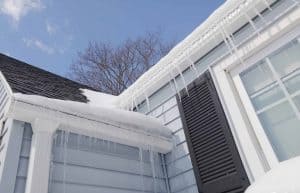But as long as humans have been walking the earth, we generally try to protect ourselves from the falling rain. From primitive cave dwellings to mud huts with tree bark on top, to copper sheets—we spare no expense when it comes to keeping our bodies and our dwellings dry.
Anyone who has experienced a leaky roof can tell you how maddening and expensive it becomes. Water belongs on the ground, in the rivers, and in lakes. Not dripping from a ceiling and saturating your carpets.
Mould quickly takes hold; drywall is almost instantly ruined, and flooring can need total removal.
Getting the water quickly and safely off the roof and diverted to where it can’t damage your home or building is essential. The longer water is in contact with your roof, the higher chance it has to infiltrate barriers and wreak havoc on interior spaces.
A Short History of Shedding Water
The first wood shingled roofs go back as far as 1,000 B.C. The Romans made concrete roofs over 2,000 years ago. When medieval Europeans got tired of their grass-thatched roofs catching on fire, they turned to ceramic tiles.
Sometime around 1,100 AD, Europeans started dealing with the perpetual roof water problem in creative ways. The first gutters and downspouts were devised to keep falling water away from the base of the structures, where splash back could wear out foundations and mar limestone exteriors.
Historically, people have used the best tool available to discharge of water off their roofs, and that’s good old gravity. The steeper the roof, the faster the water leaves. The shallower the pitch, the longer the water has time to cause its damage. That’s why, when you visit Europe, you will see medieval churches with impossibly steep roofs. Hard to get up there to repair them, but great for shedding water in the long term.
Flat Roofs Drainage System
Steep roofs come with a price. They are expensive to build, dangerous to maintain, and create unusable space in the attic. As soon as modern materials such as felt paper and tar made it possible in the 1800s, we started constructing flat roofs. Today, more engineered products such as TPO, PVC and EPDM rubber roofing have made flat roofs even more waterproof. However, do have their issue. We find that modified bitumen, flat roof solution to be the best for most low slope use cases.
Flat roofs have the advantage of being cheaper to construct, and they can hold the fancy modern machinery we use to keep interiors humming along, like giant heating and cooling units. These rooftops can nowadays be used recreationally for BBQ’s and even small farms.
But, since the water won’t leave naturally, we came up with a counterintuitive solution. Flat roofs often send the water into a centrally located drainpipe that runs through the middle of the building and out into the sewer system. Now, instead of discharging water away from the building, it is gravity fed to the centre.
An Old Problem Becomes a New Solution
Since we’ve become so adept at getting, and keeping, the water out of our structures, we have ended up creating some new problems. All that water must go somewhere. It frequently overwhelms sewage systems and drainage pipes, leading to combined sewage overflows (raw sewage flowing into rivers). Many municipalities are encouraging and rewarding homeowners, and sometimes forcing new building and parking lot construction to disconnect downspouts and redirect the water onto lawns and into bioswales.
These ingenious little mini habitats absorb and recharge groundwater while creating green spaces, bird habitat, and otherwise improving the aesthetic appearance of desolate parking lots.
Not to be outdone, municipalities are encouraging the collection of more rain, seeing as otherwise good stuff that just happens to come in inconvenient torrents. Rain barrels, which were recently illegal in many cities, are now being encouraged, to keep as much water as possible for dry spells. These can be as simple as a 55-gallon drum or as spiffy as a 1,200-gallon outdoor cistern. A well-designed rain capture system can grab up to 600 gallons (ca. 2,728 litres) off a 1,000 square foot (92.9 m²) roof in just one hour of heavy rain.
What was once a nuisance is becoming a resource for commercial buildings as well. Many are directing rainwater into huge underground cisterns, filtering it, and reusing it for interior use. Tanks as large as 3,000 cubic feet (ca. 84,951 l) are being installed to capture runoff from industrial buildings, and this is happening all around the world.
A Delicate Balance
Keeping dry and protected from the elements requires a thoughtful analysis of a roof’s pitch, materials, eave length and more. A professional can advise you and save you thousands in future repairs, simply by helping to ensure the water gets off your house as quick as possible and by choosing the right roofing materials for your specific conditions.
Call Whalley Roofing today at (403) 288-8819, and we’ll make sure you’re covered, for the long haul.


